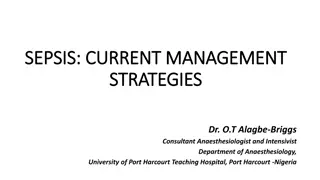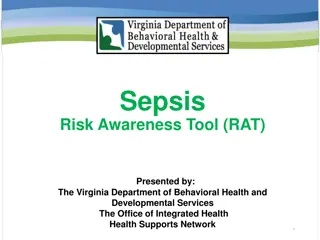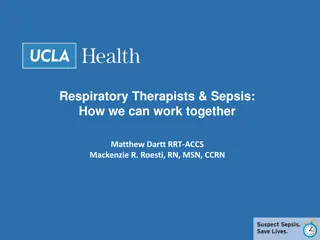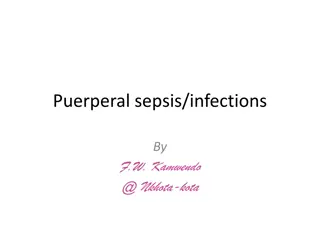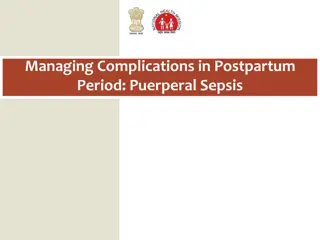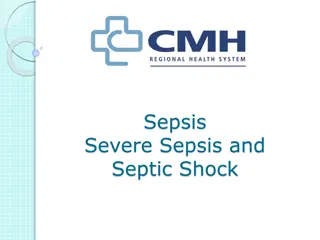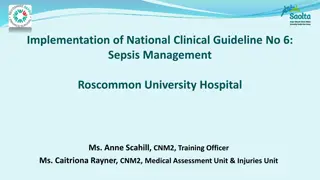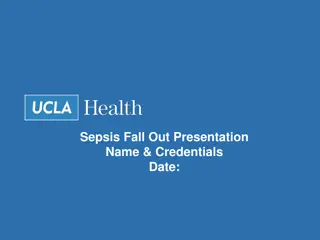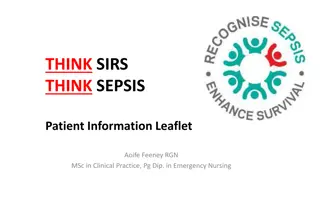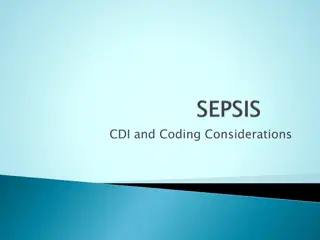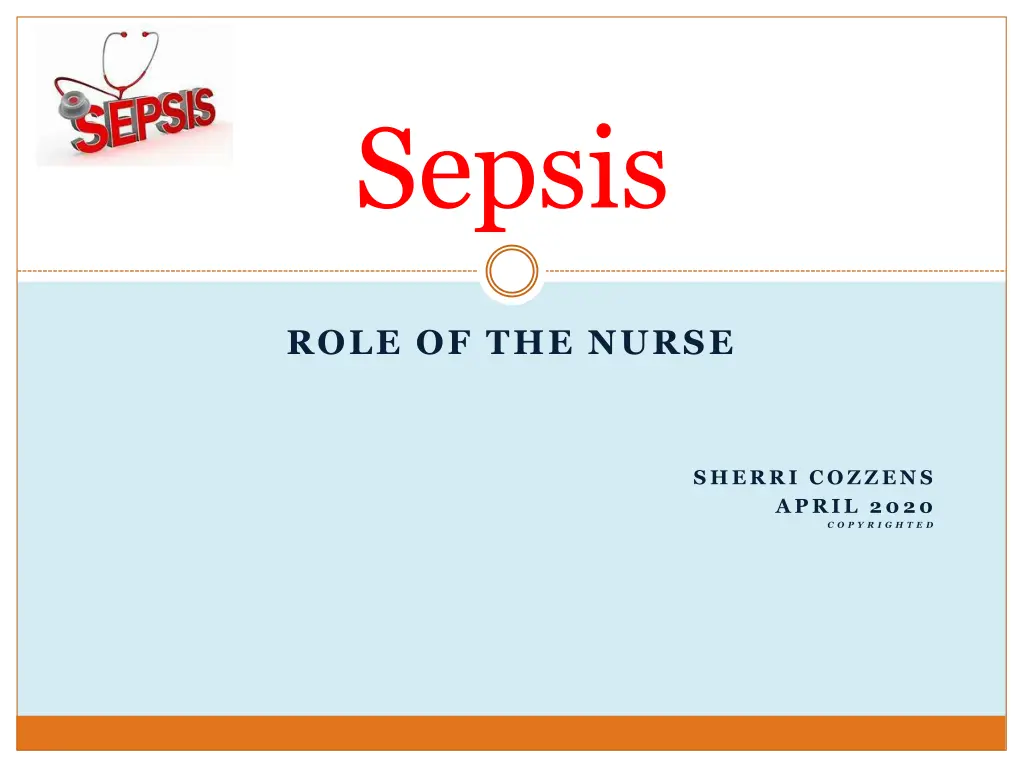
Understanding Sepsis: Role of the Nurse and Risk Factors
Explore the critical role of nurses in managing sepsis, the causes, risk factors, and increasing incidence of this life-threatening condition. Discover why anyone can be at risk and the common types of infections associated with sepsis.
Download Presentation

Please find below an Image/Link to download the presentation.
The content on the website is provided AS IS for your information and personal use only. It may not be sold, licensed, or shared on other websites without obtaining consent from the author. If you encounter any issues during the download, it is possible that the publisher has removed the file from their server.
You are allowed to download the files provided on this website for personal or commercial use, subject to the condition that they are used lawfully. All files are the property of their respective owners.
The content on the website is provided AS IS for your information and personal use only. It may not be sold, licensed, or shared on other websites without obtaining consent from the author.
E N D
Presentation Transcript
Sepsis ROLE OF THE NURSE SHERRI COZZENS APRIL 2020 C O P Y R I G H T E D
Special thanks to Cassie Kruse, RN, MSN Kelly Nguyen, RN, MSN For their excellence and their respective original presentations, from which some of these slides were prepared
Sepsis- What is it? Systemic inflammation from infection Bacterial, viral, or fungal source Inflammatory response exceeds localized area of infection Organisms and their toxins enter the blood organs Medical emergency! Septic Shock MODS Local Infection Systemic Infection Organ Failure SIRS Death
Sepsis- Is it common? 30 million people annually worldwide In the United States alone Currently more than 750, 000 cases of severe sepsis annually Severe sepsis mortality rates are approx. 28-50%, 4 or more organs increases to 75-80% More deaths than the number of deaths from prostate cancer, breast cancer and AIDS combined
Sepsis- On the rise Incidence is increasing in the U.S. Why??? Increased awareness and tracking Aging population Chronic disease Antibiotic resistant organisms Increasing invasive procedures Broader use of immunosuppressive and chemotherapeutic agents
Sepsis- Who is at risk? Anyone can get sepsis Certain conditions/situations increase risk Infants Elderly Immunosuppression Chronic illness Invasive Procedures Trauma, injury
Sepsis- Who is at risk? Certain conditions/situations increase risk Invasive lines, tubes, drains Hospitalized patients Pre-existing infections
Sepsis- What Causes It? Most common types infections that are associated with sepsis Lungs Urinary tract Gut Skin Common germs that lead to sepsis Staphylococcus aureus Escherichia coli (E. coli) Streptococcus (several strains)
Sepsis Progression: The Basics www.nysut.org
Sepsis Progression Systemic Inflammatory Response Syndrome (SIRS). A group of clinical criteria that indicate a systemic reaction to an insult. SIRS Sepsis Severe Sepsis Septic Shock
SIRS Characterized by the presence of two or more of the following: Core temp >38.3o C (101o F) or <36o C (96.8o F) Heart rate >90 bpm Respiratory rate >20 bpm WBC count > 12,000 or <4,000 Normal WBC with 10% bands (IG s)
Sepsis Progression Systemic Inflammatory Response Syndrome (SIRS). A group of clinical criteria that indicate a systemic reaction to an insult. SIRS Two or more SIRS with a known or suspected infection. Sepsis Severe Sepsis Septic Shock
Sepsis Progression Systemic Inflammatory Response Syndrome (SIRS). A group of clinical criteria that indicate a systemic reaction to an insult. SIRS Two or more SIRS with a known or suspected infection. Sepsis Sepsis with acute sepsis-induced hypoperfusion or organ dysfunction. Severe Sepsis Septic Shock
Hypoperfusion and Organ Dysfunction Increased need for oxygen A common early sign is increased RR! Acute change in mental status SBP < 90 mmHg or MAP < 65 mmHg Lactate > 2.0 mmol/L . Creatinine > 2.0 or urine output < 0.5mL/kg/hr for 2h Bilirubin > 2mg/dL Platelet count < 100,000 INR > 1.5 or aPTT > 60sec DIC
Sepsis Progression Systemic Inflammatory Response Syndrome (SIRS). A group of clinical criteria that indicate a systemic reaction to an insult. SIRS Two or more SIRS with a known or suspected infection. Sepsis Sepsis with acute sepsis-induced hypoperfusion or organ dysfunction. Severe Sepsis Severe sepsis with sepsis-induced hypotension persisting despite adequate fluid resuscitation & requiring vasopressors. Septic Shock
Watch out for Sepsis Symptoms can be vague, be alert to changes, compare patient trends. Don t miss them! Early clues Temp > 101 F (38.3 C) or less than 96.8 F (36 C) Heart rate > 90 bpm- tachycardic Respiratory > 20 bpm- tachypneic Mental status changes Hypotension Late to the game Decreased cardiac output-poor perfusion-ischemia Decreased capillary refill, mottling, or cyanosis. Absent bowel sounds-ileus Low urine output DIC
Sepsis- Laboratory No single lab test confirms sepsis Hallmark diagnostics includes Increased serum lactate (tissue hypoxemia) procalcitonin Normal or low WBC segmented neutrophils, band neutrophils (left shift) Associated with abnormalities from the underlying cause of sepsis or to tissue hypoperfusion or organ dysfunction
Sepsis- What is your role? Prevention Know the signs/symptoms and risks Evaluate at risk patients Hand hygiene & aseptic technique Remove catheters & IV lines when not needed Patient education for prevention and identification Early Detection Assess for clinical manifestations of infection & SIRS criteria RR>20, mental status changes are early signs Observe for changes (physical assessment, labs, behavior) Assess Observe
Sepsis- What is your role? Interventions Call Sepsis Alert or Rapid Response Report findings/suspicions to provider Request Lactate/Procalcitonin, blood cultures, ABG s Implement treatment as prescribed/per standard protocol Establish/maintain IV access NS 2-3 liters; will add dextrose later IV antibiotics usually 2 Oxygen Anticipate transfer to critical care or stepdown unit for possible Meds: steroids, bicarb, others Central/arterial line placement Vasopressor support Mechanical ventilation Assess Observe Report Act

